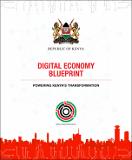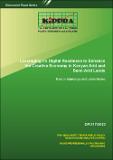Discussion Paper No. 347 of 2024 on The Creative Economy in Kenya: An Assessment of the Policy and Institutional Environment
Publication Date
2024Author
Type
KIPPRA Publicationsviews
downloads
Metadata
Show full item recordBy
Gitonga, Anne; Shibia, Adan & Githinji Njenga
Abstract/
The creative economy, a key priority of the Bottom-up Economic Transformation Agenda, can potentially contribute to the achievement of the Kenya Vision 2030, which underscores the realization of a knowledge-based economy. While it is gaining policy attention, there is a dearth of literature on the creative economy to guide planning and budgeting. This study analyzed the policy and institutional environment for three clusters of the creative economy industries: core creatives (music, stage plays, literature and publications, and visual arts); core cultural creative industries (films and museums); and related industries (fashion design and architecture). To provide a holistic view of the constraints facing this industry, a value chain approach was used to assess policy and institutional gaps. The concentric circles model guided in clustering the creative economy activities. This clustering was then subjected to value chain analysis covering the creation, production, dissemination, exhibition, and consumption of the creative products. The analysis revealed several policy initiatives aimed at nurturing and supporting the various creative industries, notably skills development, infrastructure, and institutional support. However, gaps exist in all creative industries, key among them being skills and training gaps, especially business skills for creatives, and inadequate training opportunities for the emerging creative sectors. There are also limitations of creative infrastructure. Creative infrastructure is largely provided by the private sector, with little coordination and mapping, and who may not meet the necessary needs and requirements of creative artists. Funding is also a constraint for creative industries. Financing mechanisms are not well designed to address the unique characteristics of the creatives, such as the high level of informality, low collateral base and a weak framework for valuation of creative assets. The challenges in accessing the essential tools and raw materials have also been established as constraints for certain creative industries, such as book publishing, fashion, and visual arts. These same creative industries are also faced with high production costs. Performing arts and film industries would benefit from an archiving policy, which is yet to be developed. Other policy gaps include lack of a national language policy or a policy for the promotion of cultural festivals. There are, however, several draft policies that may offer appropriate policy interventions but were not yet operational at the time of undertaking this study. These include the draft Film Policy, the draft Music Policy, and the draft Creative Economy Policy. On the legislative front, there are draft laws aimed at addressing some legislative gaps. These are the Culture Bill, Heritage and Museums Bill and the Kenya National Library Service Bill.
Subject/
Creative Economy; Knowledge-Based Economy; Cultural Diversity; Cultural Heritage; Performing Arts
Publisher
The Kenya Institute for Public Policy Research and Analysis (KIPPRA)Series
DP/347/2024;Collections
- Discussion Papers [348]
Related items
Showing items related by title, author, creator and subject.
-
Digital Economy Blueprint: Powering Kenya’s Transformation
Ministry of Information Communication and Technology (Government of Kenya, 2019)This Blueprint seeks to provide a conceptual framework adopted by Kenya in its quest towards the realisation of a successful and sustainable digital economy. It commences with a brief overview of the digital economy ... -
Discussion Paper No. 317 of 2023 on Leveraging on Digital Readiness to Enhance the Creative Economy in Kenyan Arid and Semi-Arid Lands
Kamuye, Kelvin & Kioko, John (The Kenya Institute for Public Policy Research and Analysis (KIPPRA), 2023)Leveraging on digital connectivity for growth of the creative economy is a key focus of Bottom-up Economic Transformation Agenda (BETA) which aligns with Kenya's Vision 2030 goal of transitioning into a knowledge-based ... -
Discussion Paper No.146 of 2013 on Cost Efficiency and Scale Economies of Kenya's Water Service Providers.
Musyoki, Hellen Kalunde (The Kenya Institute for Public Policy Research and Analysis (KIPPRA), 2013)Kenya has adopted Integrated Water Resources Management and instituted water sector reforms, which have led to commercialization of water supply and sanitation (WSS) services to enhance sustainability in the management ...



